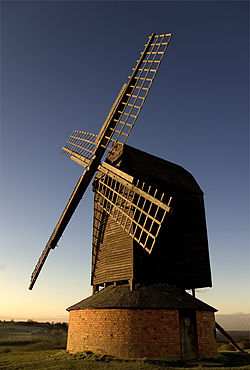Brill Windmill
| Brill Windmill | |
|
Buckinghamshire | |
|---|---|
 Brill Windmill | |
| Type: | Windmill |
| Location | |
| Grid reference: | SP654140 |
| Location: | 51°49’16"N, 1°3’7"W |
| Village: | Brill |
| History | |
| Windmill | |
| Information | |
| Owned by: | Council |
| Website: | Brill Windmill |
Brill Windmill stand in Brill, a village in Buckinghamshire. It is one of the most ancient and valuable post mills in the country. The mill stands on a hilltop in the village, prominent against the sky: it is the village's major landmark and a prominent landmark in the county. It is Grade II* listed.
The has timbers which have been dated from 1685, and thus Brill Windmill provides one of the earliest and best preserved examples of a post mill (the earliest type of European windmill) in Britain. Comparible is the even earlier seventeenth century Pitstone Windmill, also in Buckinghamshire.
Brill Windmill was last owned and operated by the Pointer and Nixie family who also baked bread in their house in the village.
In 1634, another post-mill was built opposite today's windmill, on the other side of the road across the Common. This windmill, known as Parson's Mill, was struck by lightning in 1905 and demolished in 1906. The tump on which it was built is still clearly visible.[1]
Management and ownership of the mill was passed to Buckinghamshire County Council in 1947 who, through a number of major interventions, have ensured that the mill still stands today. In 1967 the Council installed a structural steel framework that helps to support the mill's ancient timber frame but means that the mill is static and can no longer turn to face the wind.
Restoration project

By the 2000s water ingress and weathering had caused timber decay to the extent that the structure's integrity was described as "At risk". The Brill Windmill Management Group was established in 2007 to help plan a restoration project and to seek the necessary funds. With funding from English Heritage and Waste Recycling Environmental Ltd, full repair and preservation work was completed by July 2009. The mill is now structurally sound and once again open to the public (with an entrance fee), once a week, between March and September.